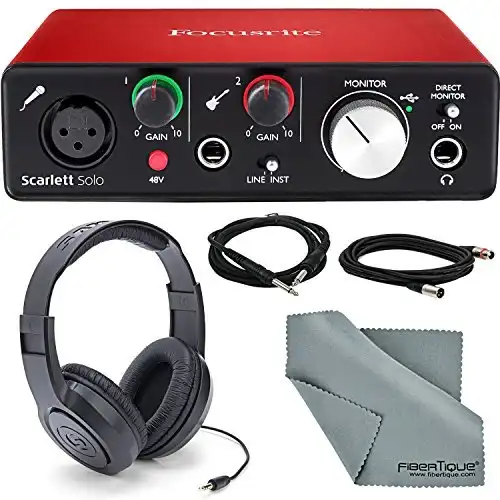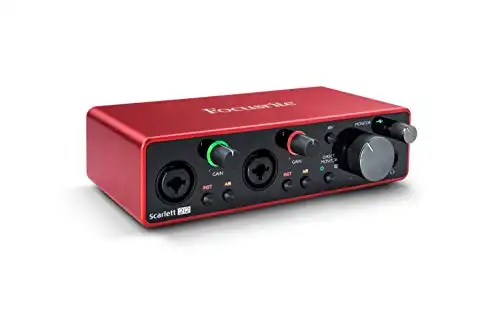When using an XLR microphone to record your podcast, you need to have one piece of equipment in your studio, an audio interface.
This genius device ensures a strong and stable connection to your microphone and allows you to record directly onto your computer. The result is a clean, interference-free sound that will give each podcast episode a clear, professional finish.
Choosing an audio interface to help you achieve that high-quality sound can be tricky. However, two stand out from the crowd – the Focusrite Scarlett Solo and the Focusrite 2i2.
Both are created by Focusrite, a brand renowned for manufacturing some of the world’s best audio interfaces.
But is the Scarlett Solo or the 2i2 better? Each has its advantages and disadvantages, and to answer this question, I decided to take an in-depth look at each.
Let’s start by looking at the differences between the two.

Table of Contents
Focusrite Scarlett Solo
Features
The first thing to note when looking at the Focusrite Scarlett Solo is its compact size. It measures just 1.73” x 5.66” x 4.7”, making it the ideal choice for a smaller-sized studio. This reduced size also makes it much easier to store, and transport should you ever want to take your show out on the road.
The Scarlett Solo is appropriately named and offers one XLR input port, so it’s ideal for solo podcasting or audiobook recording. It also features an incredibly easy-to-use interface that consists of a microphone gain dial and a monitoring dial.
There’s also an input port and accompanying gain dial for musical instruments, which allows you to record music with it, too, if you wish.
It also features QuickStart technology, taking all of the technicalities out of setting it up and allowing you to plug the interface into your computer, connect your XLR microphone, and start recording.
As well as being smaller than the 2i2, the Scarlett Solo comes at a reduced price. However, this is because of removing one of the XLR ports. Of course, this is fine if you’re a solo podcaster, as you’ll only need to use one microphone.
But if you’re planning on bringing a guest onto your show, then the 2i2 would be the better option.
See the Latest Pricing on Amazon
Pros:
- Offers direct monitoring with a simple flick of a switch
- Compact and lightweight, making it perfect for smaller studios or life on the road
- Zero-latency recording
- Provides a secure connection to an XLR microphone
- It is compatible with a plethora of popular DAWs
- Powered by a USB cable for convenience
Cons:
- It only has one XLR input port, so while it’s ideal for solo podcasters, it’s not the best option for panel shows or interview formats.
User experience
In general, this device has been fairly praised on Amazon. Users were satisfied with its effects, tools, and features for a reasonable price.
The functionality combined with an affordable price point makes this product the perfect addition to any home studio setup. As one user stated, one can never go wrong with Focusrite!
But opinions sometimes vary, and it’s important to know that some users didn’t get what they expected from their purchase. Namely, one customer laments that the item suffered significant damage upon delivery.
Focusrite 2i2
Features
While the Focusrite 2i2 is larger and heavier than the Scarlett Solo, it offers an additional XLR input port.
This means you’ll be able to connect two microphones to the interface at once, so it’s ideal for achieving high-quality audio when you’re interviewing a guest.
This second input port allows you to record each microphone to its own channel using your DAW, making the editing process much easier.
As with the Scarlett Solo, the 2i2 has an easy-to-use interface consisting of clearly labeled dials and switches. Setup is easy, too, thanks to the QuickStart tool, which automatically provides prompts and even takes you straight to a webpage where you can customize the installation.
One standout feature of the Focusrite 2i2 is its dual preamps. This means that each voice will be produced clearly and concisely. These preamps also feature a switchable ‘Air Mode’ accessed by a simple button touch, giving your recordings a brighter, more open sound.
The 2i2 comes with a host of professional tools, including the First Focusrite Creative Pack, Softube Time & Tone Bundle, Focusrite’s Red Plugin Suite, and a 3-month Splice Subscription.
It even includes your choice of one free XLN Addictive Keys Virtual Instrument, which is ideal if you want to add some music to your show.
However, it is worth noting that each of these needs to be downloaded to your computer, so you’ll need to consider your available storage space.
See the Latest Pricing on Amazon
Pros:
- It offers two XLR inputs, making it perfect for recording with two separate microphones at once
- It also offers dual preamps that ensure each voice is captured separately with equal levels of clarity.
- Although larger and heavier than the Scarlett Solo, the 2i2 is still compact enough to transport easily or fit into a smaller studio.
- Works with a wide range of DWAs
- Features direct monitoring
Cons:
- It is more expensive than the Scarlett Solo due to the additional input port and dual preamps.
- While the Scarlett Solo and the 2i2 have many differences, both have a couple of things in common. Let’s take a look at these below.
User experience
Another great product, as plenty of positive online feedback showcases. And if you’re new to podcasting, this might be exactly what you need since reviewers report it to be great for any level of audio production!
According to users, the Focusrite 2i2 it’s a powerful box with a lot of software and added plug-ins. Downloading all the plug-ins might take some time, and some people wish there were a quicker way.
As a downside, installing the software can also be tricky if you’re not too tech-savvy. Users advise to always install the FocusRite Control software before plugging in the interface to prevent any driver update issues.
Characteristics
Resolution
The Scarlett Solo and the 2i2 have 24bit/192kHz A/D resolution, which ensures that a life-like sound is captured in a conversation.
This is ideal when you’re recording a podcast since you’ll want the vocals you’re capturing to sound as clear as possible while giving your listeners the illusion of those voices physically being in the room.
Direct Monitoring
The Scarlett Solo and the 2i2 offer direct monitoring, which means that the input signal from your microphone doesn’t have to be sent to your DAW. This is an outstanding feature for podcasting!
Namely, there is zero latency between the sound you’re creating and the sound you hear in your headphones, leading to a smooth, seamless recording session.
By removing any possible latency and monitoring everything in real-time, there’s much less chance of getting confused over who is speaking and eliminating any extraneous sound.
Size
While both are small, the Scarlett Solo is compact and lightweight, so it’s ideal for smaller studio spaces and taking from place to place.
This allows you to record from a remote location with greater ease and will enable you to take your preferred recording equipment to a guest’s studio.
Which is better?
As you can see, there are similarities and differences between the Focusrite Scarlett Solo and the Focusrite 2i2. You’d need to think about your show’s format to determine which would be better for your podcasting needs.
The Scarlett Solo and the 2i2 are super easy to set up and use, which is a great thing to have in common. This means you’ll spend less time having to worry about fiddling with software, and, instead, you’ll be able to start recording pretty much straight away.
If you’re the host of a solo podcast and it’s just yourself speaking on your show each episode, then the Scarlett Solo would be a good choice. This is because it only has one XLR input port.
Comparatively, the Focusrite 2i2 features two XLR input ports. This makes it a better choice for co-hosted podcasts, interviewing guests, or panel shows.
It is a little more expensive than the Scarlett Solo, but it does offer you more in terms of what you can do. Not to mention, it comes with an included tools bundle that will help you produce the highest quality podcast possible.
Conclusion
It’s super difficult to find fault with either of them, but if I were forced to pick a winner, I’d have to say the 2i2 comes out on top!
Sure, it’s a little larger than the Scarlett Solo, but its additional ports and dual preamps offer an extra layer of versatility. It’s a little higher in cost, but if you can afford to stretch your budget, it’s worth investing in.
After all, even if you’re hosting a solo podcast at the moment, there’s nothing to guarantee that you won’t want to bring a guest in to interview or change the format of your show at some point.
With the Focusrite 2i2, you’ll save money as you won’t have to purchase a new audio interface should these situations arise.
Frequently Asked Questions
Do I need an audio interface for podcasting?
Not necessarily, but it is recommended. An audio interface makes the process easier as it allows you to connect dynamic mics. They are also helpful for recording multiple tracks for different speakers, which is impossible when using USB mics with no audio interface.
Is an audio interface necessary for streaming?
Generally, no. Some streamers may prefer the studio-quality sound produced by an audio interface, while others may be perfectly content with simply using their PC and a few other basic tools.
How do I record a podcast on Scarlet 2i2?
To start, you will need to connect your Cloud Lifter (or another inline preamp) to the Scarlett 2i2 using the included cables. Next, make sure that your Phantom Power is enabled. Additionally, connect your headphones to monitor the recording process as you go.
To adjust the levels, turn up the Microphone Gain on the front panel of the Scarlett 2i2 unit until the green ring blinks regularly. With this done, open up Garageband or another audio recording software of your choice and start assigning channels as needed.
Finally, hit record and press ‘play’ on whatever source material you plan on including in your podcast.


